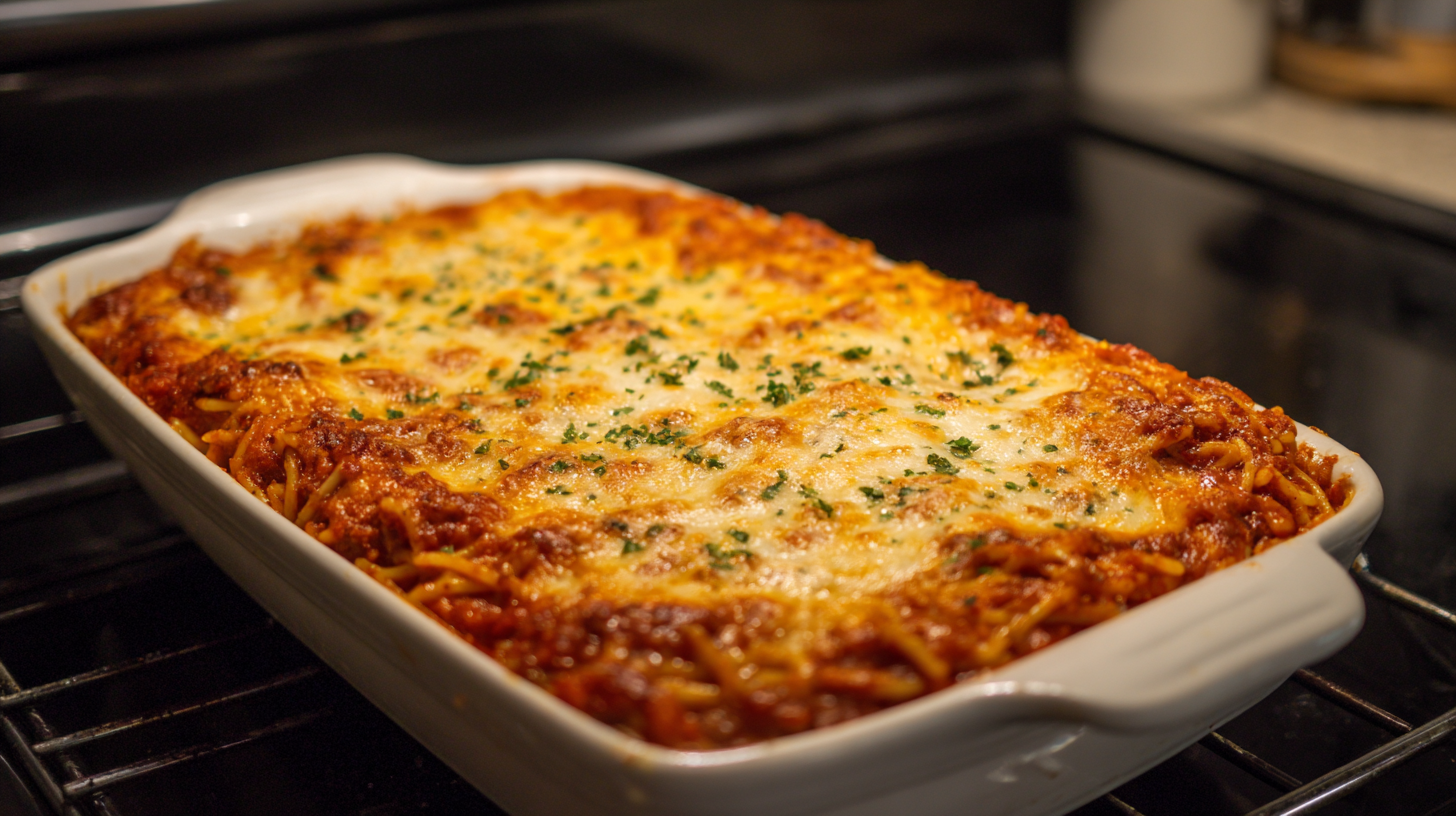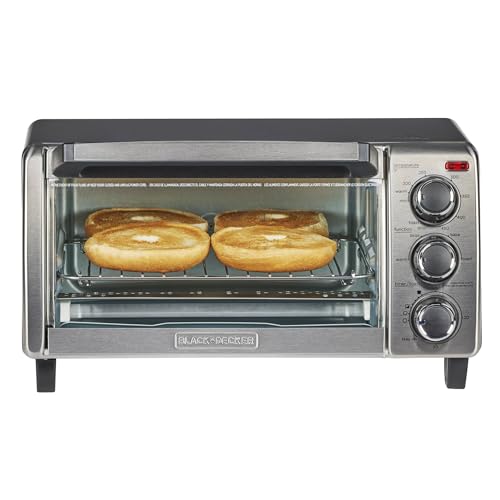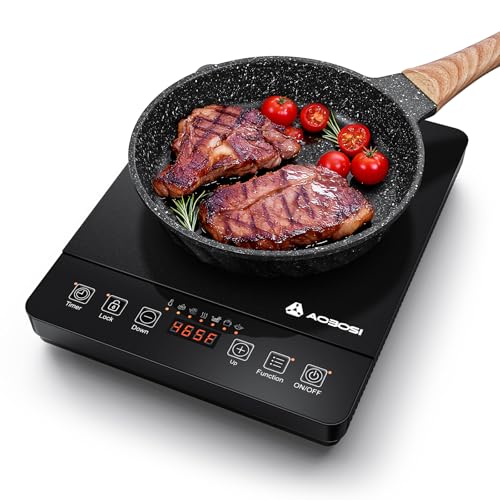Why This Baked Spaghetti Recipe Is a Family Favorite
This baked spaghetti recipe has earned permanent status in our weekly meal rotation for good reason. Kids absolutely devour it thanks to the familiar flavors wrapped in a fun new package. The combination of tender pasta smothered in savory meat sauce and topped with gooey melted cheese creates an irresistible dish that satisfies even the pickiest eaters.
Meal prep becomes incredibly simple since you can prepare this casserole ahead of time. Just assemble everything the night before then pop it in the oven when you get home from work. Your family will think you spent hours in the kitchen when dinner appears on the table just 30 minutes after walking through the door.
The versatility of this dish makes it perfect for any occasion. Serve it on busy weeknights alongside a simple salad or bring it to potlucks where it consistently disappears first. Many readers report it as their go-to dish for taking to new parents or neighbors in need because it travels well and reheats beautifully.
Budget-conscious cooks appreciate how this recipe stretches ingredients to feed many mouths. One batch easily serves 8-10 people and costs significantly less than ordering takeout. The leftovers taste even better the next day as the flavors continue to develop overnight in the refrigerator.
Customization options abound with this flexible recipe. Swap ground beef for turkey or Italian sausage depending on your preference. Add mushrooms zucchini or bell peppers to incorporate more vegetables. Some families love sprinkling extra Italian seasoning or red pepper flakes to create their signature version that becomes uniquely theirs over time.
What You’ll Need for This Baked Spaghetti Recipe

Gathering your ingredients and tools before starting will make this baked spaghetti recipe come together smoothly. This comforting casserole requires simple pantry staples and a few fresh ingredients.
Key Ingredients
- 1 pound spaghetti noodles
- 1 pound ground beef (or Italian sausage)
- 1 medium onion, diced
- 3-4 cloves garlic, minced
- 2 (24 oz) jars marinara sauce (or homemade sauce)
- 2 teaspoons Italian seasoning
- 1/2 teaspoon red pepper flakes (optional)
- 8 oz cream cheese, softened
- 1/4 cup sour cream
- 3 cups shredded mozzarella cheese, divided
- 1 cup grated Parmesan cheese, divided
- Salt and pepper to taste
- 2 tablespoons fresh parsley, chopped (for garnish)
Kitchen Tools and Equipment
You’ll need several basic kitchen tools to prepare this baked spaghetti dish effectively. A large pot works best for boiling the pasta until al dente. Choose a deep skillet or Dutch oven for preparing the meat sauce to prevent splatter. Select a 9×13 inch baking dish for assembling and baking your casserole to perfection. Measuring cups and spoons ensure accurate ingredient proportions. Keep a wooden spoon or spatula handy for stirring the sauce and breaking up meat. Aluminum foil helps cover the dish during baking to prevent over-browning. A sharp knife makes cutting through the finished casserole easier when serving. Set out a cheese grater if using block cheese rather than pre-shredded varieties. Have mixing bowls available for combining the creamy cheese mixture and other components.
Preparing the Meat Sauce
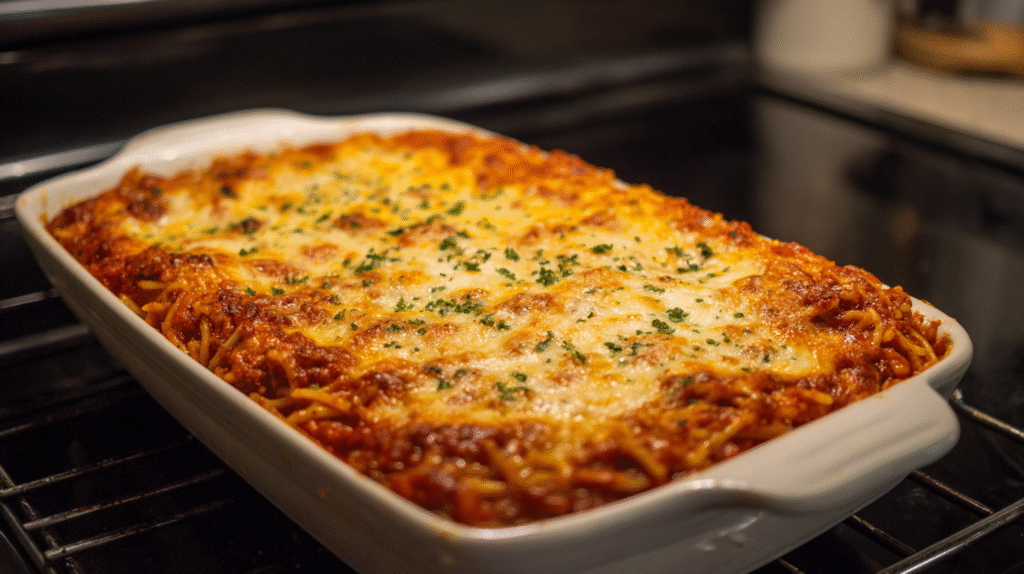
The heart of any great baked spaghetti lies in its rich flavorful meat sauce. This foundation layer brings depth and satisfaction to the entire dish while binding all other components together.
Cooking the Perfect Meat Base
Begin by heating a large deep skillet over medium-high heat. Add 1-2 tablespoons of olive oil to coat the bottom of the pan. Once the oil shimmers drop in 1 pound of ground beef (or substitute Italian sausage for extra flavor). Break the meat into small crumbles with a wooden spoon or spatula as it browns. Cook the meat thoroughly until no pink remains about 5-7 minutes. Proper browning creates rich caramelized flavors that elevate your sauce beyond basic.
Toss in one finely diced medium onion and 3-4 minced garlic cloves after the meat has browned. Sauté these aromatics until the onion becomes translucent and fragrant about 3-4 minutes. The onion and garlic form crucial flavor building blocks that will infuse throughout your sauce. For additional depth consider adding finely diced carrots and celery at this stage creating a traditional soffritto base.
Drain excess fat if necessary especially when using higher fat content ground beef. A little fat adds flavor but too much can make your final baked spaghetti greasy. Leave just enough to keep everything moist and flavorful.
Adding the Sauce and Seasonings
Pour in a 24-ounce jar of good quality marinara sauce once your meat base is ready. Quality matters here as the sauce provides substantial flavor to your dish. Homemade sauce works beautifully if you have it available but a premium store-bought version delivers excellent results for weeknight cooking.
Stir in 1 teaspoon each of dried oregano and dried basil to enhance the Italian flavor profile. Add ½ teaspoon of crushed red pepper flakes if you enjoy a slight heat kick. Season with salt and black pepper to taste remembering that the cheese layers will add saltiness later.
Bring the sauce to a gentle simmer then reduce heat to medium-low. Allow everything to cook together for at least 10-15 minutes letting the flavors meld and develop. The sauce should thicken slightly during this time creating the perfect consistency for coating pasta.
For extra richness stir in 2 tablespoons of tomato paste during the last few minutes of simmering. This concentrated flavor booster adds depth and body to the sauce. A splash of red wine (about ¼ cup) introduces wonderful complexity if you have some available.
Taste your sauce before removing from heat making final adjustments to seasonings. The perfect meat sauce should taste robust and well-balanced with no single flavor overwhelming the others. Your meat sauce is now ready to transform ordinary spaghetti into an extraordinary baked casserole.
Cooking the Pasta
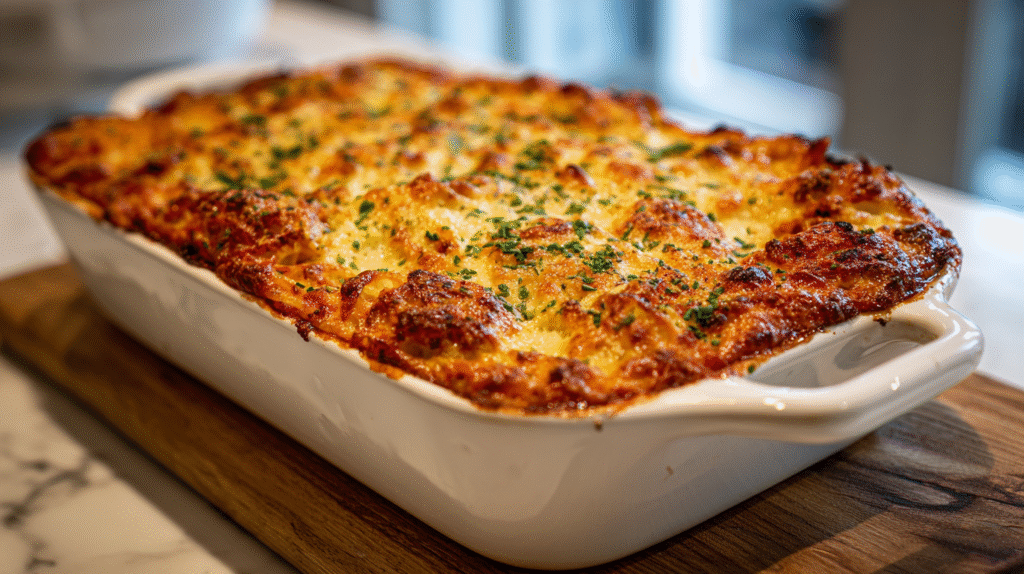
Properly cooked pasta forms the foundation of an exceptional baked spaghetti. The goal is to achieve pasta that maintains its structure throughout the baking process without becoming mushy.
Tips for Al Dente Spaghetti
Always use a large pot with plenty of water to give your spaghetti room to cook evenly. Salt the water generously—it should taste like seawater—to season the pasta from within as it cooks. Stir the spaghetti immediately after adding it to the boiling water to prevent clumping. Set a timer for 2 minutes less than the package directions recommend since the pasta will continue cooking in the oven. Test a strand before draining; it should offer slight resistance when bitten but not have a hard center. Drain the pasta thoroughly but don’t rinse it—the starch helps the sauce adhere better. Toss the hot spaghetti with a tablespoon of olive oil if you won’t be adding it to the sauce immediately to prevent sticking. Remember that proper al dente pasta makes the difference between a mediocre and magnificent baked spaghetti casserole.
Assembling Your Baked Spaghetti
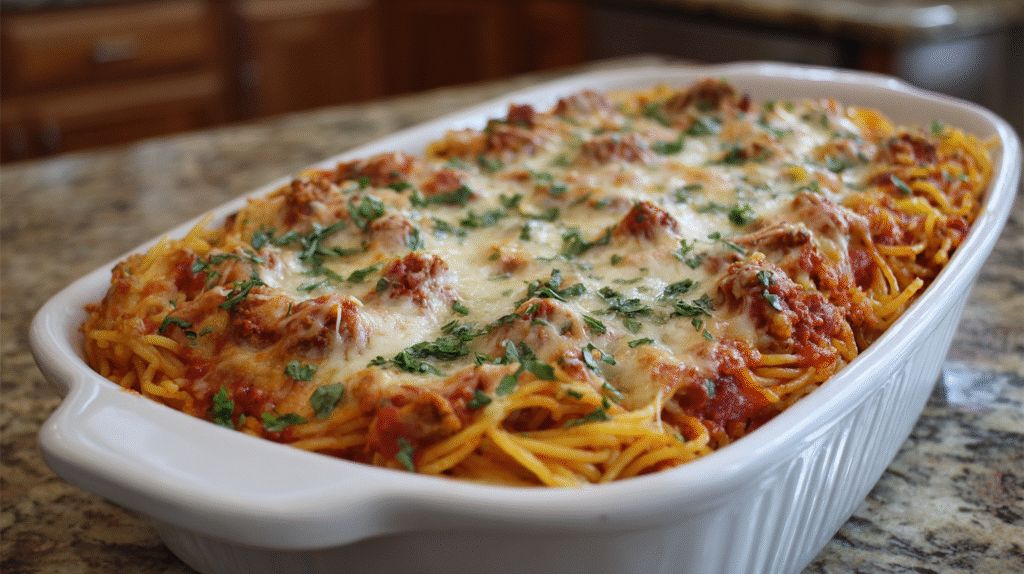
Now that your meat sauce and pasta are ready it’s time to transform these elements into a layered masterpiece. The assembly process is what sets baked spaghetti apart from its stovetop counterpart creating those irresistible textures and flavors that make this dish so craveable.
Layering Technique
Start by preheating your oven to 350°F and lightly greasing your 9×13 inch baking dish with cooking spray or butter. Pour about ½ cup of the meat sauce into the bottom of the dish and spread it evenly to create a thin base layer that prevents sticking. Add half of your cooked spaghetti to the dish spreading it out to form an even layer. Take 4 ounces of softened cream cheese and dot it across the pasta layer then gently spread it with the back of a spoon for a creamy middle section that will melt beautifully when baked.
Next pour half of your remaining meat sauce over the cream cheese layer making sure to distribute it evenly. Add the second half of your spaghetti creating another even layer. Pour the remaining meat sauce over the top ensuring all pasta is covered to prevent dry edges during baking. This methodical layering creates distinct sections that meld together during the baking process while maintaining their unique textures.
For a variation try mixing your spaghetti with two beaten eggs and ½ cup of grated parmesan before layering. This technique creates a more cohesive pasta layer that slices beautifully similar to a traditional pasta pie. You might also consider adding a layer of sautéed vegetables between pasta layers for added nutrition and flavor complexity.
Cheese Selection and Application
The cheese topping is crucial for achieving that Instagram-worthy cheese pull and golden-brown crust that makes baked spaghetti irresistible. Start with a generous layer of shredded mozzarella approximately 2 cups spread evenly across the top of your casserole. Mozzarella provides that classic stretchy texture when melted creating beautiful cheese pulls when served.
Enhance the flavor profile by mixing your mozzarella with other complementary cheeses. Add ½ cup of sharp cheddar for a tangy contrast or ½ cup of provolone for a more sophisticated flavor. A ¼ cup of freshly grated parmesan sprinkled on top adds a nutty salty finish that browns beautifully during baking. For those who enjoy a more complex cheese profile try this combination:
| Cheese Type | Amount | Flavor Contribution |
|---|---|---|
| Mozzarella | 1½ cups | Meltability and stretch |
| Provolone | ½ cup | Smoky depth |
| Cheddar | ½ cup | Sharp tangy notes |
| Parmesan | ¼ cup | Nutty finish and browning |
Apply your cheese blend evenly ensuring complete coverage of the sauce layer. Pay special attention to the edges which tend to dry out first during baking. For an extra-special touch create a cheese border by pressing additional cheese around the perimeter of the dish creating a caramelized cheese crust that becomes everyone’s favorite part.
Before baking cover your assembled spaghetti with aluminum foil to trap moisture during the initial cooking phase. You’ll remove this cover during the final 10-15 minutes of baking to allow the cheese to develop that coveted golden-brown finish with slightly crispy edges that provide textural contrast to the tender pasta below.
Baking Instructions
Transforming your assembled spaghetti casserole into a bubbling masterpiece requires proper baking technique. Follow these detailed instructions to achieve that perfect golden-brown crust and melty cheese interior.
Temperature and Timing
Preheat your oven to 375°F (190°C) before inserting your baked spaghetti. Place the assembled casserole on the middle rack where heat distribution remains most consistent. Cover the baking dish tightly with aluminum foil to trap moisture and heat during the initial baking phase. Bake the covered spaghetti for 25 minutes to allow the internal layers to heat thoroughly without burning the cheese. Remove the foil and continue baking for an additional 10-15 minutes until the cheese develops that irresistible golden-brown finish. Total baking time typically ranges from 35-40 minutes depending on your oven’s calibration. For a deeper browning effect without overcooking the pasta, you can switch to the broiler setting for the final 2 minutes while watching carefully to prevent burning.
How to Know When It’s Done
Your baked spaghetti displays several telltale signs when perfectly cooked. The edges should bubble vigorously with sauce that appears thick rather than watery. Cheese on top must reach a golden-brown color with some darker spots indicating proper caramelization. Insert a knife into the center – it should feel hot to the touch when removed, confirming the middle has heated through completely. The casserole needs to rest for 10-15 minutes after removing from the oven, allowing the molten interior to set slightly for easier serving. During this resting period, the internal temperature continues cooking the dish while making it easier to cut clean portions. Watch for a slight pulling away from the sides of the baking dish, which indicates the casserole has set properly. Properly baked spaghetti maintains its structure when served rather than collapsing into a messy pile on the plate.
Make-Ahead and Storage Options
Baked spaghetti shines as a meal prep champion with its excellent make-ahead qualities. Discover how to prepare this family favorite in advance and store it properly for future enjoyment.
Freezing Instructions
Baked spaghetti freezes beautifully for up to 3 months when properly prepared. To freeze an entire casserole before baking assemble all layers in a freezer-safe aluminum pan then wrap tightly with plastic wrap followed by aluminum foil. Label with the date and cooking instructions for future reference.
For freezing individual portions after baking allow the casserole to cool completely then slice into serving sizes. Place each portion in airtight containers or wrap in plastic wrap and aluminum foil. Stack the portions in your freezer to maximize space.
If you plan to freeze your baked spaghetti undercook the pasta slightly more than usual (about 3 minutes less than package directions) to prevent it from becoming mushy when reheated. Consider omitting vegetables that release water like zucchini or mushrooms as they can make the defrosted dish soggy.
For best results thaw frozen baked spaghetti overnight in the refrigerator before reheating. You can bake a frozen uncooked casserole directly from the freezer but add an extra 20-30 minutes to the cooking time and keep it covered with foil until the final 15 minutes.
Reheating Your Baked Spaghetti
Refrigerated leftovers retain their quality for up to 4 days when stored in airtight containers. The flavors actually intensify overnight making next-day baked spaghetti even more delicious than freshly made.
Oven reheating provides the best results for maintaining the casserole’s texture. Preheat your oven to 350°F (175°C) place the refrigerated portion in an oven-safe dish cover with aluminum foil and heat for 20-25 minutes until the internal temperature reaches 165°F (74°C). Remove the foil for the last 5 minutes to re-crisp the cheese topping.
Microwave reheating works well for single portions when you’re short on time. Place a slice on a microwave-safe plate cover with a damp paper towel to prevent drying and heat on medium power for 2-3 minutes checking halfway through. Let the portion stand for 1 minute before serving to ensure even heat distribution.
For the freshest taste when serving make-ahead baked spaghetti you can prepare the components separately up to 2 days in advance. Store the cooked pasta tossed with a little olive oil the prepared meat sauce and the cheese mixture in separate containers in the refrigerator. Assemble the casserole about 30 minutes before you plan to bake allowing extra time (about 10-15 minutes) since all components will be cold.
Add a splash of water or extra marinara sauce when reheating larger portions to prevent the pasta from drying out. A sprinkle of fresh cheese on top before the final reheating adds a renewed melty finish that makes leftovers taste freshly made.
Serving Suggestions
Your baked spaghetti deserves to be presented with complementary sides and beverages that enhance the overall dining experience. Transform this hearty casserole into a complete meal with these serving ideas.
Side Dishes That Complement Baked Spaghetti
A fresh green salad provides the perfect contrast to the rich flavors of baked spaghetti. Try a simple arugula salad with lemon vinaigrette or a classic Caesar with homemade croutons for a refreshing counterpoint. Garlic bread stands as the traditional partner to any pasta dish and works wonderfully to soak up extra sauce from your plate. For a lighter option roasted vegetables like asparagus broccoli or Brussels sprouts balance the heartiness of the casserole with their earthy flavors and varied textures.
Italian-inspired antipasto platters featuring olives marinated artichokes cured meats and various cheeses make an impressive starter before serving your main dish. Sautéed greens such as spinach kale or Swiss chard with garlic and red pepper flakes add a nutritious element that cuts through the richness of the baked spaghetti. For family-style dinners consider serving breadsticks or soft dinner rolls alongside your casserole to satisfy hearty appetites.
Beverage Pairings for Maximum Enjoyment
Medium-bodied red wines like Chianti Sangiovese or Merlot complement the tomato-based sauce in baked spaghetti without overwhelming it. Their acidity balances the richness of the cheese while their fruit notes enhance the savory meat flavors. Non-alcoholic options include sparkling water with lemon Italian sodas or unsweetened iced tea with a splash of fresh lemon juice.
For casual family dinners lemonade or flavored water serves as a refreshing palate cleanser between bites of the hearty casserole. Coffee or espresso makes an excellent follow-up beverage especially when served alongside a light dessert after your meal. Create beer enthusiasts might appreciate pairing amber ales or lagers with baked spaghetti as their maltiness complements the dish’s robust flavors.
Presentation Tips for Impressive Serving
Use a wide flat spatula to serve intact portions that showcase the distinct layers of your baked spaghetti. Fresh herbs sprinkled on top just before serving add vibrant color and aromatic appeal to your casserole. Consider warming your dinner plates in the oven for a few minutes before plating to keep servings hot longer.
For casual gatherings place the entire baking dish on a trivet at the center of the table surrounded by your chosen side dishes for a family-style service. Grate additional Parmesan cheese into a small bowl with a tiny grater alongside so guests can add their desired amount. For more formal occasions individually plate portions with a side salad and garlic bread arranged thoughtfully for visual appeal.
Accommodating Dietary Preferences
Offer a small bowl of additional red pepper flakes for heat-loving guests to customize their portions. Create a separate smaller casserole without meat for vegetarian guests using mushrooms zucchini or plant-based ground protein alternatives. For gluten-sensitive diners prepare a portion using gluten-free pasta which maintains its texture well in baked dishes.
Consider making a dairy-light version with less cheese for lactose-sensitive guests or those watching their fat intake. Keep extra sauce warmed separately for those who prefer more moisture in their pasta dishes. Providing these thoughtful options ensures everyone at your table can enjoy this comforting classic regardless of their dietary needs.
Recipe Variations
Transform this classic baked spaghetti recipe to suit your taste preferences or dietary needs with these creative alternatives. These variations maintain the comforting essence of the original dish while introducing exciting new flavors.
Vegetarian Version
Creating a meatless baked spaghetti is simple and equally satisfying. Replace the ground beef with hearty vegetables like diced eggplant mushrooms zucchini and bell peppers sautéed until tender. You can also incorporate plant-based protein options such as crumbled tofu veggie ground round or lentils to maintain a substantial texture. Enhance the umami flavor by adding a tablespoon of soy sauce or a teaspoon of miso paste to your marinara sauce. For extra nutrition toss in some fresh spinach or kale during the assembly process allowing the greens to wilt naturally from the heat of the other ingredients. The cheese components remain the same but consider using vegetarian-friendly parmesan as traditional versions often contain animal rennet.
Spicy Alternative
Kick up the heat in your baked spaghetti by transforming it into a fiery delight. Start by adding hot Italian sausage or spicy ground beef to your meat mixture for an immediate flavor boost. Incorporate diced jalapeños or serrano peppers when sautéing your onions and garlic. Spice lovers can enhance the marinara sauce with cayenne pepper crushed red pepper flakes or a tablespoon of your favorite hot sauce. Try mixing in pepper jack cheese with the mozzarella for an additional spicy element throughout the casserole. Before baking sprinkle some red pepper flakes on top for both visual appeal and extra heat. Serve this spicy version with cooling sides like sour cream or a crisp cucumber salad to balance the intense flavors.
The Perfect Baked Spaghetti: Final Thoughts
You’ve now mastered a crowd-pleasing dish that brings comfort food to a whole new level. This baked spaghetti transforms ordinary pasta night into something special while keeping preparation simple and stress-free.
Whether you’re feeding a hungry family on a weeknight or impressing guests at your next gathering this hearty casserole delivers consistent results every time. The combination of tender pasta perfectly cooked meat sauce and that irresistible cheese crust creates a dish that’ll have everyone asking for seconds.
Don’t be afraid to make it your own by experimenting with different proteins vegetables and cheese combinations. Your baked spaghetti will quickly become a signature dish in your cooking repertoire and a beloved staple on your dinner table for years to come.

